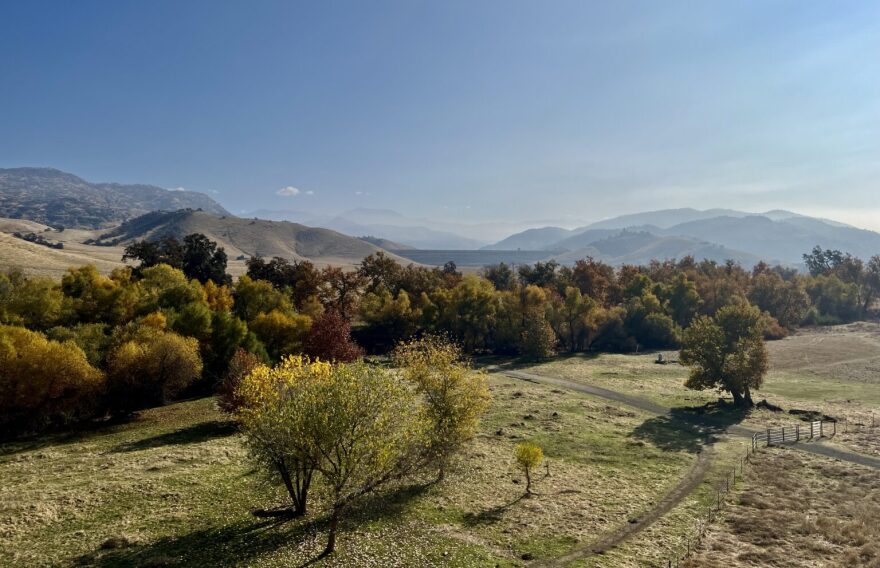While many San Joaquin Valley towns were shrouded in tule fog, about 35 locals enjoyed a day under bright sunshine along a creekbed, dodging cowpies and traipsing through crunchy, golden sycamore leaves.
On the annual Sequoia Riverlands Trust Kaweah Watershed Tour Wednesday, a mix of farmers, new trust employees, Americorps volunteers and those who are simply curious learned how water flows and is managed throughout the Kaweah watershed. The tour is part of the trust’s education mission of conserving the lands and waters of California’s heartland.
Guests stopped at two nature preserves and got a look at the innards of Terminus Dam, the structure that impounds Lake Kaweah in eastern Tulare County.
At each stop, the cycles of drought and floods that are the norm for the region spurred hours of questions and conversation.
“This is flood and drought country,” said guide John Greening, a retired College of the Sequoias biology professor.
Homer Ranch Preserve
At an impressive 1,800 acres northwest of Lemon Cove, this preserve’s crown jewel is the second largest sycamore alluvial woodland in California.
Greening said there are just 17 similar woodlands left in the state because they can only survive on undammed waterways. The trees follow Dry Creek, which itself is unique for its north-south path. Most channels in the watershed run east to west and carry more water, thus Dry Creek’s name.
Volunteers had been planting seedlings along the creek bed to encourage the stand’s regeneration but those were washed miles downstream during the floods of March 2023.
Greening said the onslaught of water brought huge amounts of sandy soil to the channel, which the sycamores thrive in. To his delight, he recently found several volunteer seedlings during a photography outing, one with four golden leaves.
“This creek drives the ecology of the entire preserve,” he said. Other trees include willows and Valley blue and live oaks. Cattle grazing helps manage growth of non-native grasses.
Dry Creek Preserve
Four miles south of Homer Ranch, Dry Creek Preserve is just 152 acres and the site of a former rock quarry. Locals may remember the controversy from the late 1990s to the early 2000s surrounding mining company Artesia’s plans to mine the area. Supporters slapped bumper stickers on their cars that read “You travel on our gravel” while farmers blamed the operation for their dry wells.
The project went bust about the same time and the trust acquired the former quarry in 2004. After years of remediation, today the preserve is the site of the trust’s native plant nursery and a popular location for dog walkers, photographers and school field trips.
“This preserve is a jewel,” said trust educational director Bud Darwin. “The public loves it.”

Mining scars are still evident from a lookout that also boasts a clear shot to the east of Terminus Dam, the next stop on the tour.
Terminus Dam
Operated by the Army Corps of Engineers, Terminus Dam was built in 1962 in response to several devastating floods that regularly swamped the growing city of Visalia.
Army Corps Park Ranger Tim Holzem regaled the tour group with facts and figures of the Kaweah watershed, the steepest in the nation.
The dam’s design is specific to its environment, he said. “Nowhere else in the world is a dam designed this way.”
For example, Terminus Dam’s six-foot core is earthen, made of clay mined from nearby Horse Creek. The porous material allows some seepage, and was a less expensive material to use. Most dams, including Pine Flat, Friant and even Hoover Dam along the Colorado River, are made of concrete.
In the late 1990s, Terminus Dam’s spillway was raised 22 feet, and guests were able to tour the cavernous engineering feat that increased Kaweah Lake’s capacity to more than 180,000 acre-feet. The dam visit included a stop in a cage-like structure designed to prevent a giant sequoia, washed down the Kaweah River from Sequoia National Park, from penetrating a funnel that manages pressure on six fuse gates during epic storm events.
Normally, outflow of water is managed in a partnership with the Kaweah Delta Water Conservation District. But in 2023’s floods, the Sacramento office of the Army Corps of Engineers took over.
“We let more water out than ever before,” Holzem said, with more than 8,000 cubic feet per second arcing out into the river below. “That’s like 8,000 basketballs floating by a second.”
The dam’s name originates from a former beach along the Kaweah River where the Visalia Electric Railroad line terminated. Residents would take the train east for a day to the old Terminus Resort, enjoying the cool waters of the river.
With navel oranges ripening in orchards below the dam, Holzem’s parting words to the crowd were: “Just remember, you’re eating oranges full of Sequoia snow!”
The preserves are open for public use on a limited basis. For more information check sequoiariverlands.org.
SJV Water is an independent, nonprofit news site covering water in the San Joaquin Valley,www.sjvwater.org. Email us at sjvwater@sjvwater.org.

